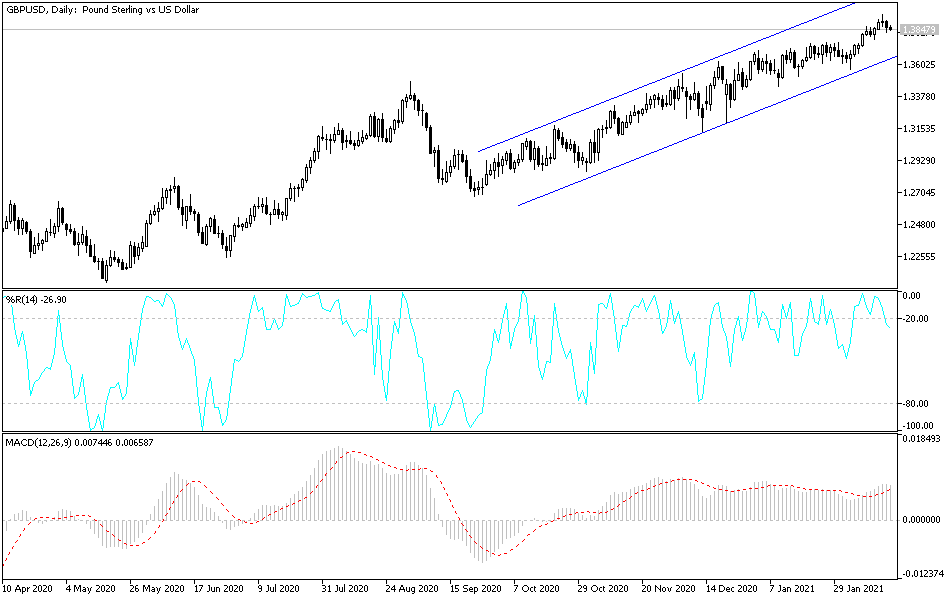Despite the recent gains of the US dollar, the GBP/USD's losses did not exceed the 1.3830 support level, settling around the 1.3870 level as of this writing. The steep bullish path for the pair was the closest to the 1.4000 psychological peak, which is still a target for bulls so far. As I mentioned before, the pound is receiving the attention of Forex traders due to the British progress in the pace of vaccinations, which speeds up the reopening of the country, making the UK a forerunner in economic recovery. The results of the British economic data and the features of the Bank of England policy may motivate traders to seize the current downside opportunities to return to buying the pair.
Although British inflation is low, it will start to rise again in the coming weeks and months, and within five years from now it may reach 2.4%, according to economists. “After four decades of declining inflation, the tide is turning in the developed world,” says Holger Schmidding, Chief Economist at Bernberg Bank. Several cyclical and long-term structural factors indicate that core inflation will rise in the coming years.
The prediction comes on the day the UK reported lower prices in January amid a sustained lockdown that ensured economic activity and unusually calm consumer patterns. The Office for National Statistics reports that UK CPI inflation came in at -0.2% month-on-month in January, down from 0.3% in December, but the number was higher than the -0.4% expected.
CPI inflation rose 0.7% year-on-year in January, higher than the December figure of 0.6% and above the consensus forecast for a reading of 0.6%. The main contributors to the downside of UK inflation data were lower prices for clothing and shoes. However, upward pressures came from furniture, household goods, restaurants, hotels, food and transportation. Since the UK was in lockdown during this period with restaurants and hotels closed, the rule by which to sample this data has been greatly reduced.
The impact of the numbers on the market has been minimal given the forward-looking nature of investors who are already looking to reopen the economy in the coming months. Samuel Toombs, Chief UK Economist at Pantheon Macroeconomics, commented: “The slight rise in CPI inflation in January is the first step this year towards a higher rate than the target by the fall.” The Pantheon Macroeconomist says that CPI inflation is likely to pick up in February and March, as the recent rise in oil prices is quickly passed on to motorists. It is expected to rise to 1.8% in April, largely due to the comparative effect of the collapse in oil prices in the previous year, which will give a technical boost to the data.
Pantheon Macroeconomic expects a rebound in service sector inflation, as demand is higher than usual once virus risks decrease. Market expectations for higher prices have started to increase recently, a development highlighted by the rise in the yield on long-term government debt. This is a typical development that occurs when investors demand more compensation for holding bonds if they believe that the value of those assets will erode due to higher inflation in the future.
Indeed, for the markets, rising UK inflation expectations will be the main focus of investors over the coming months as rising inflation may push central banks to withdraw the liquidity stimulus that has been the main driver of the booming stock markets.
Technical analysis of the pair:
Despite the recent sell-offs of the GBP/USD, the general trend remains bullish, and a breach of the resistance 1.3900 will support expectations that the pair is ready to breach the 1.4000 psychological resistance in response to the factors mentioned above. On the downside, according to the performance on the daily chart, the bears will gain control over the pair and bullish expectations will collapse if the pair moves towards the support levels 1.3755 and 1.3600. Still, I would prefer to buy the pair on every downside.
Today's economic calendar:
All attention will be on the results of the US data, as the reading of the Philadelphia Industrial Index, the number of weekly jobless claims, then building permits and housing starts will be announced.


